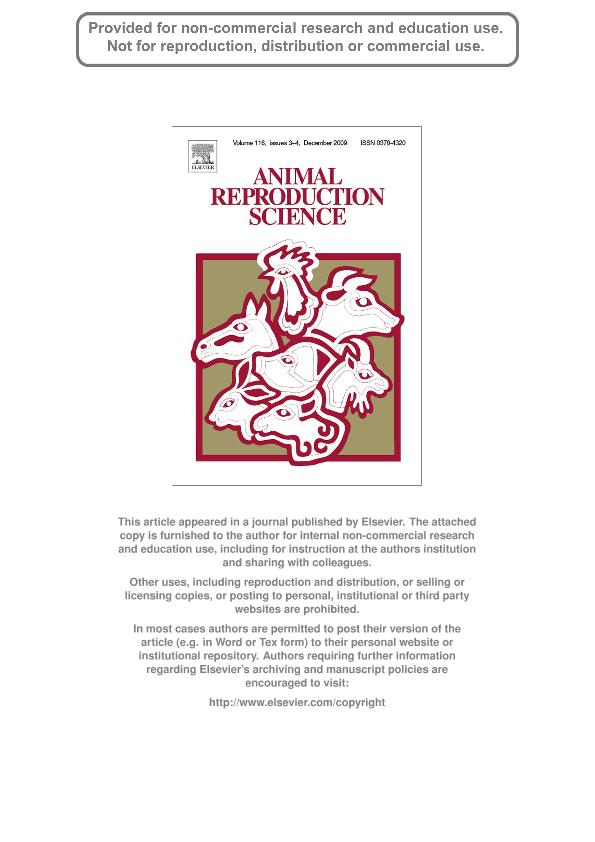Mostrar el registro sencillo del ítem
dc.contributor.author
Superina, Mariella

dc.contributor.author
Carreño, Norma Beatriz

dc.contributor.author
Jahn, Graciela Alma

dc.date.available
2019-07-16T19:26:36Z
dc.date.issued
2009-12
dc.identifier.citation
Superina, Mariella; Carreño, Norma Beatriz; Jahn, Graciela Alma; Characterization of seasonal reproduction patterns in female pichis Zaedyus pichiy (Xenarthra: Dasypodidae) estimated by fecal sex steroid metabolites and ovarian histology; Elsevier Science; Animal Reproduction Science; 116; 3-4; 12-2009; 358-369
dc.identifier.issn
0378-4320
dc.identifier.uri
http://hdl.handle.net/11336/79669
dc.description.abstract
Reproductive strategies vary considerably among species, but most studies have focused on a very limited number of mammalian species. Knowledge of the reproductive cycle and behavior is essential for developing and implementing in situ and ex situ conservation strategies for threatened and endangered species. This study aimed at characterizing the seasonal reproductive pattern of female pichis Zaedyus pichiy, a threatened small armadillo native to arid regions of Argentina and Chile, through direct observations, histological studies, and by measuring fecal immunoreactive estrogens, progestagens and glucocorticoids in 10 wild-born, captive pichis and in free-ranging individuals. Results suggest that pichis are seasonal breeders that give birth to one yearly litter of 1-2 offspring, which do not leave the burrow until they are weaned at approximately 37 days. Ovarian follicular growth seems to occur throughout the year. Fecal progestagen, estrogen and glucocorticoid concentrations were minimal during the first half of pregnancy, increased to peak concentrations of up to 3500, 200 and 200 ng/g dry feces, respectively, and decreased before parturition. Postpartum progestagen concentrations were greater in lactating females than females that aborted or did not raise their offspring (p < 0.0001), which is probably related to an elevated corticosteroid synthesis that contributes to maintain lactation, given that fecal glucocorticoid concentrations were of similar pattern. Observations of a second pregnancy after late abortion or death of the newborn litter and sustained follicular growth during pregnancy and lactation suggest that female pichis can become receptive briefly after having lost their litter. Fecal estrogen and progestagen concentrations of non-pregnant, non-lactating females did not have a well-defined hormonal cyclic pattern, and corpora lutea were only observed in pregnant females.
dc.format
application/pdf
dc.language.iso
eng
dc.publisher
Elsevier Science

dc.rights
info:eu-repo/semantics/openAccess
dc.rights.uri
https://creativecommons.org/licenses/by-nc-sa/2.5/ar/
dc.subject
Dasypodidae
dc.subject
Ovarian Histology
dc.subject
Pichis-Fecal Hormone Metabolites
dc.subject
Xenarthra
dc.subject.classification
Biología Reproductiva

dc.subject.classification
Ciencias Biológicas

dc.subject.classification
CIENCIAS NATURALES Y EXACTAS

dc.title
Characterization of seasonal reproduction patterns in female pichis Zaedyus pichiy (Xenarthra: Dasypodidae) estimated by fecal sex steroid metabolites and ovarian histology
dc.type
info:eu-repo/semantics/article
dc.type
info:ar-repo/semantics/artículo
dc.type
info:eu-repo/semantics/publishedVersion
dc.date.updated
2019-06-10T21:44:56Z
dc.journal.volume
116
dc.journal.number
3-4
dc.journal.pagination
358-369
dc.journal.pais
Países Bajos

dc.journal.ciudad
Amsterdam
dc.description.fil
Fil: Superina, Mariella. University Of New Orleans; Estados Unidos. Consejo Nacional de Investigaciones Científicas y Técnicas. Centro Científico Tecnológico Conicet - Mendoza. Instituto de Medicina y Biología Experimental de Cuyo; Argentina
dc.description.fil
Fil: Carreño, Norma Beatriz. Consejo Nacional de Investigaciones Científicas y Técnicas. Centro Científico Tecnológico Conicet - Mendoza. Instituto de Medicina y Biología Experimental de Cuyo; Argentina
dc.description.fil
Fil: Jahn, Graciela Alma. Consejo Nacional de Investigaciones Científicas y Técnicas. Centro Científico Tecnológico Conicet - Mendoza. Instituto de Medicina y Biología Experimental de Cuyo; Argentina
dc.journal.title
Animal Reproduction Science

dc.relation.alternativeid
info:eu-repo/semantics/altIdentifier/doi/http://dx.doi.org/10.1016/j.anireprosci.2009.02.015
Archivos asociados
